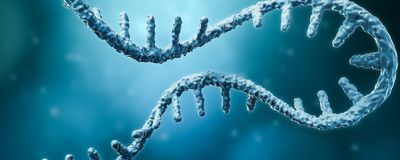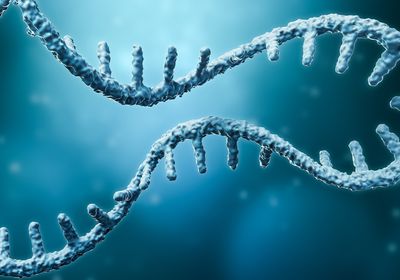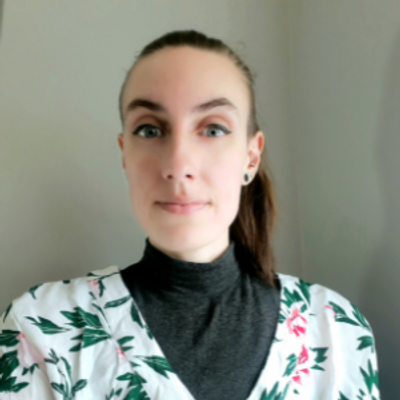ABOVE: Researchers edit RNA to bypass genome editing limitations in CAR T cell engineering. © iStock, libre de droit
Many foundational research technologies have transformed cellular therapies, moving treatments from concept to clinic. In the past decade, chimeric antigen receptors (CAR) and genome editing are two standouts that led to breakthrough CAR T cell therapies for leukemia and lymphoma.1 Scientists engineer these treatments with virus-mediated gene insertion ex vivo, which instructs T cells to express synthetic receptors that detect tumor-specific antigens and guide cancer cell eradication after transplantation.2 Researchers investigate clustered regularly interspaced short palindromic repeats (CRISPR) editing to improve CAR T cell therapies and expand their applicability to more cancer types.3 However, CRISPR-associated nuclease 9 (Cas9)-based genome cutting tools face unique safety and efficacy limitations due to the permanent nature of DNA editing.
“Our years of experience on gene editing at the DNA level makes us realize that this technology, while very powerful, still has some intrinsic challenges, which could possibly only be addressed if we find methods to engineer RNA.”
– Stanley Qi, Stanford University
To circumvent these limitations, bioengineer Lei (Stanley) Qi and physician immunologist Crystal Mackall at Stanford University developed an RNA editing tool called multiplexed effector guide arrays (MEGA). In a study published in Cell, the team used Cas9’s cousin, Cas13, and a pooled array of guide RNAs to simultaneously edit multiple gene transcripts in primary human T cells without targeting or cutting genomic DNA.4 This multi-targeting method addresses an unmet need in cell therapy optimization by allowing the researchers to dynamically regulate several pathways per T cell, rather than add or ablate individual genes completely, one at a time. The researchers screened for genes that synergistically affect T cell function and knocked down redundant transcripts that drive T cell exhaustion in culture and in mice.
“Our years of experience on gene editing at the DNA level makes us realize that this technology, while very powerful, still has some intrinsic challenges, which possibly could only be addressed if we find methods to engineer RNA,” said Qi. Among these difficulties are off-target cuts and accumulation of genomic instability through multiple DNA edits. “RNA is completely different. If we target RNA, we do not touch the DNA all, and RNA editing is reversible,” Qi explained. Another advantage is Cas13’s ability to process several unique guide RNAs from a single array, which allowed the researchers to target multiple RNA transcripts at once in the same cell.
The research team first put MEGA through its paces in cell culture. To validate the tool, they targeted three previously established inhibitors of T cell function at once, which effectively suppressed T cell exhaustion. The research team also performed a large-scale, combinatorial screen with multiple guide arrays, uncovered new genetic regulators of T cell function, and created a drug-inducible form of MEGA for dose-responsive CAR activation. They then used MEGA to enhance CAR T cell fitness and anti-tumor activity in cancer cell co-cultures and in a mouse model of leukemia by disrupting multiple metabolic pathway components in T cells before transplantation.
“This is a beautiful paper. It adds another dimension to what we have already been able to do with DNA-targeting CRISPR by taking advantage of this excellent RNA-targeting CRISPR platform,” said Neville Sanjana, a bioengineer at New York University who was not involved in this study. “We need a broad genome engineering toolbox. They're great tools, Cas9 and Cas13, but being able to turn genes on and off, and to do this in multiplexed ways, that's the future that we really want.”
This future may also include new avenues for controlling T cell exhaustion, which could further enhance CAR T therapies and other immune cell-based treatments, particularly for treating solid tumors. Qi and Mackall’s findings revealed metabolic signaling as a potential modifiable pathway involved in T cell exhaustion, shifting beyond the conventional focus on CAR activation. “I think what's emerging right now is a landscape of CAR plus—not just putting in a CAR, but being able to do other things to the T cells to make them more persistent and more capable,” said Sanjana. “I think the way that it's shown here by Stanley and Crystal and team is exactly part of that future.”
- Chen Y, et al. CAR-T: What is next?Cancers. 2023;15(3):663.
- Tsuchida CA, et al. Mitigation of chromosome loss in clinical CRISPR-Cas9-engineered T cells. Cell. 2023;186(21):4567-4582.e20.
- Zhou X, et al. Applications of CRISPR technology in cellular immunotherapy. Immunol Rev. 2023;320(1):199-216.
- Tieu V, et al. A versatile CRISPR-Cas13d platform for multiplexed transcriptomic regulation and metabolic engineering in primary human T cells. Cell. 2024;187(5):1278-1295.e20.




